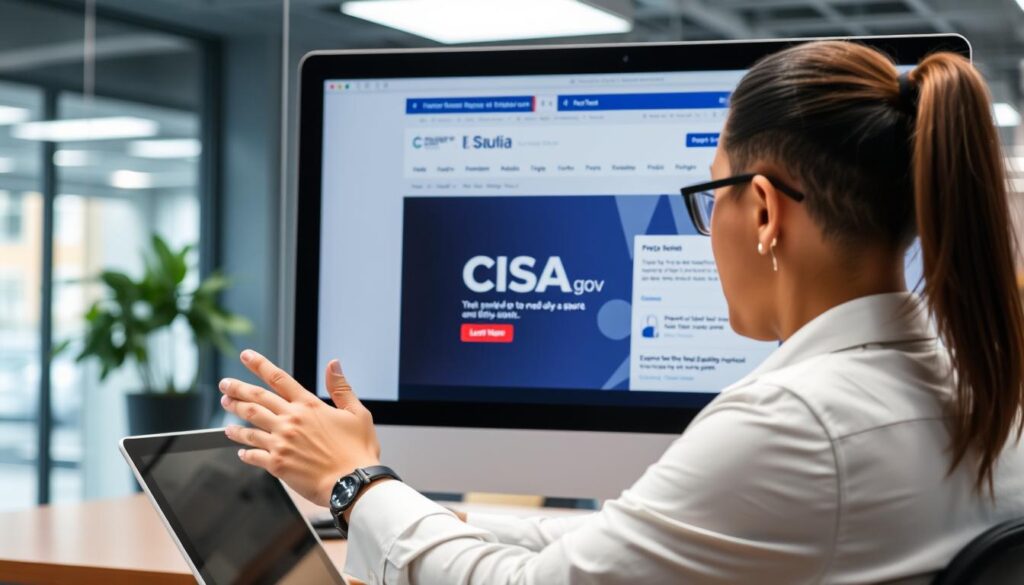In today’s digital landscape, cyber threats are escalating at an unprecedented rate, making it imperative for businesses of all sizes to bolster their cybersecurity posture. The Cybersecurity and Infrastructure Security Agency (CISA) plays a vital role in helping organizations protect themselves against these threats.
As you navigate the complex world of cybersecurity, understanding how to leverage CISA’s resources and expertise can be a game-changer for your business. This comprehensive guide will walk you through the process of establishing a productive relationship with CISA, from understanding eligibility requirements to implementing their security recommendations on your websites.
Key Takeaways
- Understand the benefits of collaborating with CISA to enhance your cybersecurity.
- Learn about the eligibility requirements for CISA’s programs and resources.
- Discover how to implement CISA’s security recommendations effectively.
- Explore special programs designed for small and medium-sized businesses.
- Gain a clear roadmap for protecting your business against evolving cyber threats.
Understanding CISA’s Role in National Security
To ensure the security of your business, it’s vital to understand CISA’s role in the broader context of national security. As a key federal agency, CISA is dedicated to improving and supporting cybersecurity across all levels of government and critical infrastructure.
What is CISA and Its Mission
CISA stands as the nation’s primary federal organization responsible for enhancing cybersecurity. Its mission involves identifying threats, reducing vulnerabilities, and minimizing the impact of cyber incidents. By doing so, CISA plays a critical role in safeguarding national security.
Why CISA Matters to Businesses of All Sizes
CISA’s guidance is crucial for businesses of all sizes because cyber threats can target any organization, regardless of scale or industry. You can access CISA’s resources through their official website, which provides authoritative information to help protect your business from evolving threats. By staying informed through CISA, you can better prepare your business against potential cyber risks.
Benefits of Partnering with CISA
When you partner with CISA, you open your business up to a wide array of cybersecurity benefits. This partnership can be a game-changer for your organization’s security posture. By working together with CISA, you can leverage their expertise and resources to enhance your cybersecurity.
Access to Cybersecurity Resources and Expertise
By partnering with CISA, you’ll gain access to a comprehensive range of free cybersecurity resources. These include threat intelligence, vulnerability assessments, and incident response support. CISA’s educational materials, training programs, and technical assistance can significantly enhance your organization’s security without a substantial financial investment. Their official .gov website and alert systems provide timely information about emerging threats, helping you stay ahead of potential attacks.
Protection Against Emerging Threats
CISA’s partnerships with private sector entities create valuable information-sharing networks that benefit all participating businesses. Their websites serve as centralized hubs for cybersecurity best practices, tools, and frameworks that you can implement in your business operations. This enables your organization to stay protected against emerging threats and maintain a robust cybersecurity posture.
Doing Business with CISA: Getting Started

To become a CISA vendor, your organization must first understand the prerequisites and initial steps involved. This involves meeting specific eligibility criteria and navigating CISA’s official .gov website to find relevant information.
Eligibility Requirements for Businesses
You’ll need to meet specific eligibility criteria to formally engage with CISA’s programs and services. This includes understanding the types of businesses that can benefit from various CISA initiatives.
Different types of businesses can benefit from CISA programs, with special attention to what small and medium enterprises should focus on.
Initial Steps to Establish a Relationship
To establish a relationship with CISA, you’ll need to navigate their .gov website to find the appropriate points of contact and program information. This involves properly completing registration processes and documentation.
You’ll understand how to effectively use CISA’s websites to access resources, submit inquiries, and track the status of your engagement with the agency.
CISA’s Small Business Support Programs

As a small business owner, you can leverage CISA’s resources to protect your organization from evolving cyber threats. CISA proudly celebrates the nation’s entrepreneurs and small businesses during National Small Business Week, May 4-10, 2025. Despite their size, small businesses are increasingly targeted by threat actors, both in cyber and physical realms.
CISA has developed specialized programs to assist small businesses in safeguarding their investments. These programs include access to free assessment tools that can help identify vulnerabilities in your small business’s cyber infrastructure.
Resources for Small and Medium Enterprises
CISA offers simplified guidance documents that translate complex security concepts into actionable steps for small business owners. You can access these resources through CISA’s secure https websites, which provide tailored cybersecurity guidance for smaller organizations.
Accessing CISA’s Small Business Week Resources
You can participate in CISA’s webinars, workshops, and training sessions designed specifically for small business leaders who need practical security advice. These resources are designed to help you protect your business against hackers and cyber criminals without requiring advanced technical knowledge.
Implementing CISA’s Cybersecurity Recommendations

To bolster your business’s defenses against cyber threats, it’s essential to integrate CISA’s cybersecurity guidelines into your security framework. By doing so, you’ll not only enhance your organization’s security posture but also ensure compliance with national security standards.
Essential Security Measures for Your Business
Your organization’s security begins with implementing fundamental security measures. Two critical aspects are multifactor authentication (MFA) and patch management.
Multifactor Authentication (MFA) Implementation
MFA is a layered approach to securing your online accounts. Any form of MFA is better than none, as it raises the cost of attack and reduces risk. For enhanced security, consider using FIDO authentication, which is phishing-resistant and built into modern browsers and smartphones.
Patch Management and System Updates
Regular patch management is crucial for addressing security issues before they become major vulnerabilities. Establish an effective update schedule to ensure your systems remain secure.
Creating an Incident Response Plan
Developing a comprehensive incident response plan is vital for your organization’s cybersecurity. This plan should align with CISA’s recommendations and best practices, ensuring you’re prepared to respond effectively in case of a security incident. Incorporating security by design principles into your business processes will also help build security into your systems from the outset.
By following these guidelines and prioritizing CISA’s security recommendations based on your organization’s specific needs and risk profile, you’ll significantly enhance your cybersecurity posture and be better equipped to handle potential security issues.
CISA’s “Secure by Design” Approach
The ‘Secure by Design’ philosophy, championed by CISA, emphasizes the importance of integrating security into the foundation of your systems. This approach is about building security into your infrastructure from the ground up, rather than adding it as an afterthought. By doing so, you can significantly reduce the risk of cyber threats and improve your overall cybersecurity posture.
One major improvement you can make is to eliminate services hosted in your offices, known as “on-premises” or “on-prem” services. Examples include mail and file storage in your office space. These systems require significant skill to secure, as well as time to patch, monitor, and respond to potential security events. Few small businesses have the necessary time and expertise to keep them secure.
Transitioning to Cloud Solutions
Moving from on-premises infrastructure to cloud-based solutions can greatly enhance your security. Cloud services provide robust security measures that are often beyond the capabilities of small businesses to implement on their own. For instance, cloud providers typically have advanced threat detection and incident response capabilities. To learn more about the impact of CISA’s “Secure by Design” pledge, visit this article for in-depth insights.
When transitioning to the cloud, consider the security advantages and potential challenges during migration. Ensure that your cloud provider complies with stringent security standards and offers the necessary support for a smooth transition.
Securing Endpoints and Websites
Securing your websites is crucial, and using https protocols is a fundamental step. CISA recommends implementing https to protect both your data and your customers’ information. Additionally, ensure that your endpoint devices, such as computers and mobile devices, are configured according to CISA’s security recommendations. This includes keeping software up-to-date and using strong passwords.
By evaluating your current technology stack against CISA’s “Secure by Design” principles, you can develop a roadmap for improving your security posture. This involves selecting and configuring endpoint devices that align with CISA’s guidelines and implementing robust security measures for your websites.
Implementing these changes without disrupting your business operations requires careful planning. Start by assessing your current security measures, identifying areas for improvement, and gradually rolling out more secure practices.
Conclusion: Your Cybersecurity Journey with CISA
Cybersecurity is a continuous process, and with CISA, you’re on the right path. To enhance your business’s cybersecurity posture, establish a productive relationship with CISA by following the key steps outlined in this article. Regularly visit CISA’s .gov website for the latest information on emerging cyber threats and to access valuable resources.
Stay connected with CISA through their website, newsletters, and social media to stay informed. By leveraging CISA as a trusted government partner, you’ll be better equipped to address cybersecurity challenges. Make it a point to use reputable websites for ongoing security education and address any new issue promptly.
FAQ
What is the purpose of CISA’s .gov website?
The CISA .gov website provides information on the organization’s mission, resources, and services to help businesses and individuals protect themselves against cyber threats and stay informed about national security issues.
How can I access CISA’s cybersecurity resources and expertise?
You can access CISA’s cybersecurity resources and expertise by visiting their website at https://www.cisa.gov/, where you can find guides, tools, and information on various cybersecurity topics, including incident response planning and essential security measures for your business.
What are the eligibility requirements for businesses to partner with CISA?
To be eligible to partner with CISA, businesses must meet certain requirements, which may include being registered in the System for Award Management (SAM) and adhering to specific cybersecurity standards and guidelines.
How can small and medium enterprises (SMEs) access CISA’s resources and support?
SMEs can access CISA’s resources and support by visiting the CISA website, attending webinars, and participating in programs such as Small Business Week, which offers specialized resources and guidance on cybersecurity and national security issues.
What is CISA’s “Secure by Design” approach, and how can it benefit my business?
CISA’s “Secure by Design” approach emphasizes the importance of integrating security into the design and development of technology products and services. By adopting this approach, your business can reduce the risk of cyber threats and improve overall cybersecurity posture.
How can I create an effective incident response plan using CISA’s recommendations?
To create an effective incident response plan, you can follow CISA’s guidelines and recommendations, which include identifying potential threats, developing response strategies, and conducting regular exercises and training to ensure readiness.
